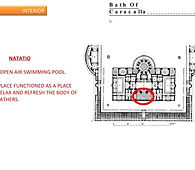~ Meera Satheesh ~
My Architectural Journey
Baths of Caracalla was the second largest Roman bath. This building was commenced by Septimius Severus, Caracalla’s father. However, he died in February 211 before he could complete it. Hence, Emperor Marcus Aurelius Severus Antoninus Augustus (Caracalla) took over the project. This bath was named after his nickname, Caracalla, which was a Gallic cloak greatly fancied by him. It was constructed parallel to the Appain way and was built between 211 and 216.
This building was approximately thirty acres and takes the shape of a humongous rectangle. This bath could hold up to 1600 bathers at a time.
Bathing was considered a luxury but also a necessity to the Romans. Emperors usually build baths as a way of showing their generosity towards the citizens and hoped for loyalty from them in return. Although there were quite a number of baths in ancient Rome, but this building was divided into mainly eight sections. Each section served different purpose.
The first section is Vestibules which is the lobby of the building.
The second section is called the apodyteria. This was a dressing room where the bathers’ belongings will be kept here in the cubicles. Slaves would sometimes be left here to look after the belongings as pickpocketing was pretty common.
The third section is called the Palaestra, a place for bathers to exercise. The light exercise was intended for the bathers to maintain good health as it was encouraged by the Roman medical profession to work up a light sweat before bathing.
The forth section is the Tepiderium. This was a warm room where bathers would use oil to loosen dirt on their bodies. They would also receive massage here and even get their body hairs removed as being hairless was considered fashionable.
The fifth section is the Laconicum. There was no bath in there and was for the bathers to break into serious sweat before proceeding to the Calidarium.
The sixth section is the Calidarium. This is the place where bathers take hot bath where the temperatures of the water would hit 38 Celsius or higher. The hot water was meant to open up the pores of the bathers.
The seventh section is the Frigidarium. After taking a hot bath, bathers would dip themselves into the cold pool to close their opened pores.
The eighth section is the Natatorium. This pool was one meter deep and was slightly warmer than the temperature of the Frigidarium pool. Bathers would often relax and swim in there.
Brick arches were used to construct the north side of the site while the opposite side was enclosed by a wall[1]. It is approximated that to build this bath, 9000 workers were hired each day for a length of 5 years. Water supply arrived at the southern side of the baths and was channelled to the rest of the building.
What makes Baths of Caracalla historically significant is that this building has made an impact on the later generations. As an example, our generation has sauna room which was inspired by the Laconicum. However, baths of Caracalla was destroyed in a gothic war and lasted for about 300 years only. Nevertheless, the ruins of the amazing architecture still remind us of how utilising space wisely is important when designing a building.
Baths of Caracalla









Model :









Presentation Board :
